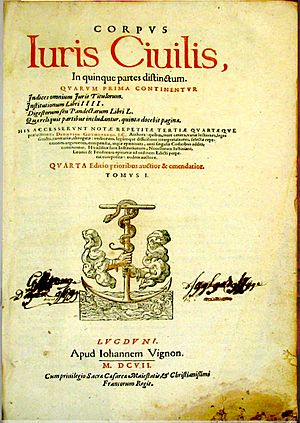Judiciary facts for kids

The judiciary (say: joo-DISH-ee-air-ee) is the system of courts that helps make sure everyone gets justice. It's like the part of the government that decides what's fair when people have disagreements. It works for the whole country or state. The word 'judiciary' also refers to all the judges and other people who work in these courts to make sure the system runs smoothly.
Contents
How Government Branches Work Together
Separation of powers means that a government has different parts, and each part has its own job. The judiciary is the part of the government that explains and applies the laws. Many governments have three main parts:
- The Legislature: This group makes the laws (like a parliament or congress).
- The Executive: This group carries out the laws (like the president or prime minister).
- The Judiciary: This group interprets the laws and makes decisions in legal cases.
Often, the judiciary has different levels of courts. There are courts where cases start (called "courts of first resort"), courts that review decisions from lower courts (appellate courts), and a very important court at the top (like a supreme court or constitutional court). If someone disagrees with a decision from a lower court, they can ask a higher court to review it. This is called an appeal.
A Look at Court History
The idea of courts and judges has changed a lot over time. Let's explore some key moments in history.
Ancient Roman Courts
In ancient Rome, the earliest laws were called Ius Civile (which means "civil law"). This included rules passed down from ancestors (Mos Maiorum) and laws made by leaders (Leges).
In the early days, legal cases had two steps:
- In Iure: This was the first step where people went to a leader (at first, priests) who would look at the laws that applied to their case.
- Apud Iudicem: Then, the case went to judges. These judges were regular Roman citizens who would decide the case based on the rules already chosen.
Later, a new leader called a praetor became in charge of the court system. Praetors would also announce new laws or rules for the year they were in charge.
As the Roman Empire grew, a new way of handling cases appeared. It was called cognitio extraordinaria (meaning "extraordinary process"). In this system, there was only one step. A professional judge, who worked for the emperor, would hear the case. If someone disagreed with the judge's decision, they could appeal to a higher official.
During this time, legal experts became very important. They studied the law and advised the emperor. They could also give legal advice to others on behalf of the emperor.
A very important collection of all Roman laws was created by Emperor Justinian. It was called the Corpus Iuris Civilis. It had four main parts:
- Institutiones: An introduction and summary of Roman law.
- Digesta/Pandectae: A collection of important legal rulings.
- Codex: All the laws made by emperors.
- Novellae: All the new laws that were created after the main collection.
Courts in the Middle Ages
During the Middle Ages, education became more common. Universities started teaching different subjects, including two main types of law:
- Canon Law: These were laws made by the Pope and the Roman Catholic Church. They dealt with church matters.
- Civil Law: This was based on the old Roman law, especially the Corpus Iuris Civilis, which was rediscovered around 1070. This law was used for everyday "worldly" issues.
Scholars at universities studied these old texts. They translated them, summarized them, and wrote comments to help people understand them better.
A monk named Gratian organized all the church laws into a collection known as the Decretum Gratiani. This became a very important part of church law for centuries.
By the 15th century, these two types of law (Canon Law and Roman Law) started to mix. This new combined system was called Ius Commune. It brought together the general rules and ideas from church law with the specific rules from Roman law. This led to more legal books and a more organized way of handling court cases.
In this new system, it was possible to appeal decisions. The legal process became a mix of two styles:
- Inquisitorial: Where the judge actively looked for all the evidence.
- Adversarial: Where both sides in a case were responsible for finding evidence to convince the judge.
After the French Revolution, there was a time when lawmakers believed only they should interpret laws, not judges. But later, this idea changed, and judges were allowed to interpret laws again.

How Courts Work in Different Legal Systems
In countries that use "common law" (like the United States or the United Kingdom), courts do more than just apply laws. They also interpret laws, including constitutions and rules. Judges also make new law in a limited way, based on decisions made in past cases. This is called "case law." For example, the idea of negligence (being careless) often comes from past court decisions, not just written laws.
When a court makes a decision in a common law system, it sets a "precedent" for all lower courts to follow in similar cases. This idea is called stare decisis.
Courts Around the World
Japan's Courts
In Japan, judges go through special training. After five years, they can become full judges. To be a judge, you usually need ten years of experience working in law. Japan's court system includes:
- The Supreme Court
- Eight high courts
- Fifty district courts
- Fifty family courts
- 438 smaller summary courts
Mexico's Courts
In Mexico, the President chooses the justices for the Mexican Supreme Court, and the Mexican Senate must approve them. These justices serve for life. Other judges are chosen by the Supreme Court and serve for six years. Mexico's federal courts include:
- 11 ministers (justices) on the Supreme Court
- 32 circuit tribunals (appeals courts)
- 98 district courts
To be a Supreme Court Justice in Mexico, a person must be between 35 and 65 years old and have had a law degree for at least five years.
United States Courts
In the United States, the President chooses the justices for the Supreme Court, and the United States Senate must approve them. These justices serve for life or until they retire. The Supreme Court is in Washington, D.C..
The U.S. federal court system has 94 federal judicial districts. These are grouped into twelve regions called "circuits." Below the Supreme Court, there are different types of federal courts, including:
- United States bankruptcy courts
- United States Court of Appeals for the Federal Circuit
- United States Court of International Trade
- United States courts of appeals
- United States district courts (where most federal cases start)
Besides the federal courts, each state, district, and inhabited territory has its own court system. These state courts handle cases about state laws. They also have their own supreme courts (or similar highest courts) for their specific area.
Images for kids
See also
 In Spanish: Poder judicial para niños
In Spanish: Poder judicial para niños




